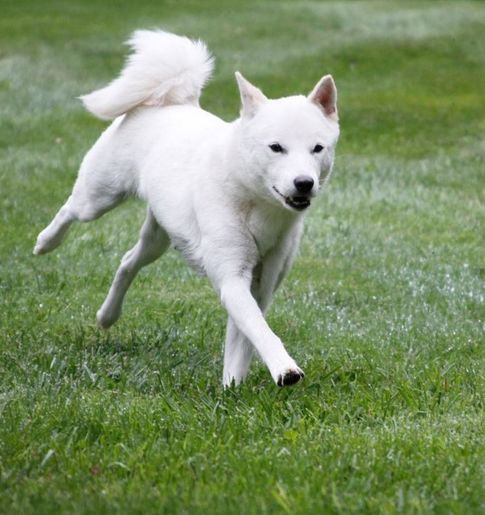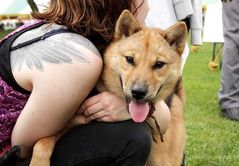Recommended Clearances
The following is a list of recommended pre-breeding health clearances in order to help advance HANA’s knowledge of breed specific health concerns for the Hokkaido. It is our club’s mission to help ensure the health and well being of Hokkaido here in North America. Thus, HANA does not support North American breeders who do not health test their breeding stock prior to breeding. HANA also recommends all breeders offer a 2-year (minimum) warranty against any hereditary health conditions in the puppies they produce.
Mandatory
- OFA or PennHIP Hip Dysplasia Evaluation
- OFA Cardiac Evaluation
- OFA CAER Eye Examination
- Collie Eye Anomaly (CEA) DNA Test
Optional
- Degenerative Maliopathy (DM) DNA Test
- Progressive Retinal Atrophy (PRA) DNA Test
- OFA Patellar Luxation Evaluation
- OFA Elbow Dysplasia Evaluation
- OFA Thyroid Evaluation
Preliminary evaluations and CAER eye exams must be done at 12 months of age or older to qualify.



Collie Eye Anomaly
Currently, the most prevalent disorder known in the breed is a non-progressive genetic mutation called Collie Eye Anomaly, or CEA. It can cause a variety of vision issues including depth perception loss, vision impairment, and in rare cases, total blindness. Because the mutation is non-progressive, whatever the puppy’s eye function is at eight weeks is the extent of the damage CEA will cause throughout that dog’s lifetime.
According to a 2011 study performed by the American College of Veterinary Ophthalmologists, an estimated one-third of Hokkaido are affected by CEA, and two-thirds carry it. However, it is estimated that nearly 90% of dogs genetically affected by the CEA mutation either do not show physical signs of the disorder, or the psychical signs are very mild. HANA recommends performing a DNA test on all breeding dogs to check for the CEA gene. At this point in time, HANA does not recommend excluding CEA affected dogs from the breeding population due to already dwindling numbers. Instead, we recommend developing a breeding plan to minimize the amount of affected puppies produced.
Heart Murmurs
Several Hokkaido in Japan have had reports of heart murmurs, enough that Japanese breeders have begun testing their breeding dogs for it. A heart murmur, put simply, is when there is a disturbance of the blood flow in the heart. They are broken down into multiple different types such as stylistic (murmur when the heart contracts), diastolic (murmur in between beats), and continuous (murmur throughout the entire heart beat cycle.) From there, they are graded on a severity scale of one to six, with one being the least severe and six being the most severe. HANA mandates OFA cardiac exams on all breeding Hokkaido, and does not recommend breeding dogs affected by heart murmurs.
Hip Dysplasia
Based upon current findings in the US and in Europe, Hokkaido are also prone to hip dysplasia, or CHD. CHD is a common structural problem affecting the canine population. It is a complex multifactorial trait which affects a large percentage of both purebred and mixed breed dogs. Dogs predisposed to hip dysplasia are born with normal hips, but quickly develop subluxation of the femoral head. Degenerative joint disease follows typically within the first year of a dog’s life. Most Hokkaido tested for CHD have come back with good or excellent hips. However, some dogs in the US population have been diagnosed with this disease so HANA recommends all Hokkaido be screened by OFA or PennHip before breeding, and all non-passing dogs should be removed from the breeding population.
Idiopathic Seizures
Some Hokkaido in the US and overseas have suffered from idiopathic seizures. This is a genetic seizure disorder in which seizures present themselves with no identifiable cause. A seizure is a sudden excessive electrical discharge of the neurons in the brain. This results in a rapid series of involuntary constrictions of otherwise voluntary muscles. In dogs, symptoms typically present themselves between 6 months and 6 years of age. This is an incurable disorder, and HANA is currently seeking more information on this issue. In the mean time, all Hokkaido experiencing idiopathic seizures (or show any evidence of epilepsy) should be removed from the breeding population in order to ensure a healthier future generation.
Anxiety, Psychogenic Polydipsia, and Pica
The Hokkaido is a naturally active and driven breed. Like all working dogs, they crave a job to do. When left alone with minimal mental or physical stimulation, Hokkaido can become bored, anxious, and hyperactive. This can quickly lead to unhealthy habits such as separation anxiety, psychogenic polydipsia, and pica.
Psychogenic polydipsia, otherwise known as compulsive water drinking, has been observed by multiple Hokkaido owners in the US. Hokkaido have been known to drink incredibly large amounts of water at a time, followed by vomiting up the excess liquid. Pica is a condition defined by a dog’s craving of non-food items, and the subsequent eating of said item. Many Hokkaido in the US have been found ingesting rocks, stick fragments, socks, tennis balls, and more. While more research is needed to determine the underlying physical or psychological cause of such disorder, it is thought to be largely energy and/or anxiety related. At this point in time, HANA does not recommend excluding dogs experiencing anxiety, psychogenic polydipsia, or pica from the breeding population.